Balloon landings are a safety-critical phase of flight. If anyone or anything is ejected from basket during landing, an accident is virtually certain because balloon is uncontrolled, passengers unattended. To avoid this, all balloon pilots should wear safety harnesses. Owners/operators should install them. Also, passenger safety briefings must be clear, concise, easy for all passengers to follow.
Executive summary Tuhinga whakarāpopoto
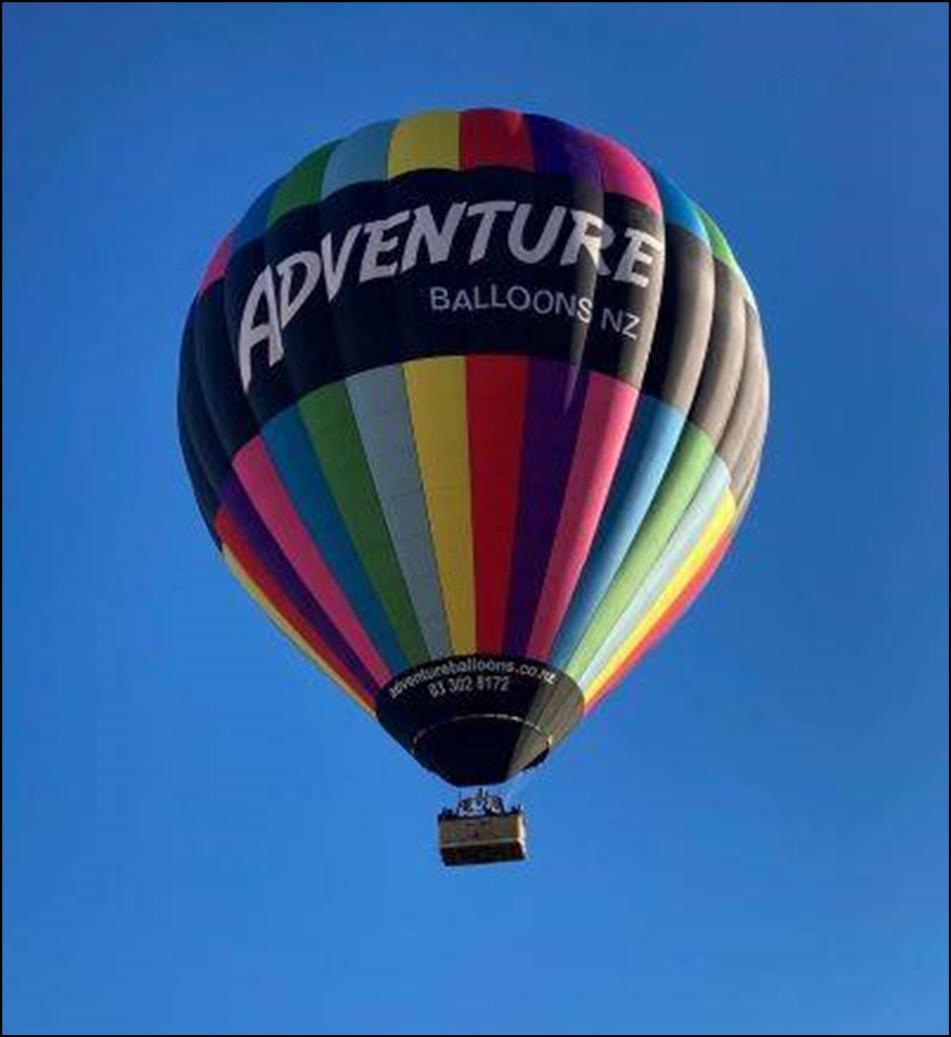
(Credit: Adventure Balloons NZ)
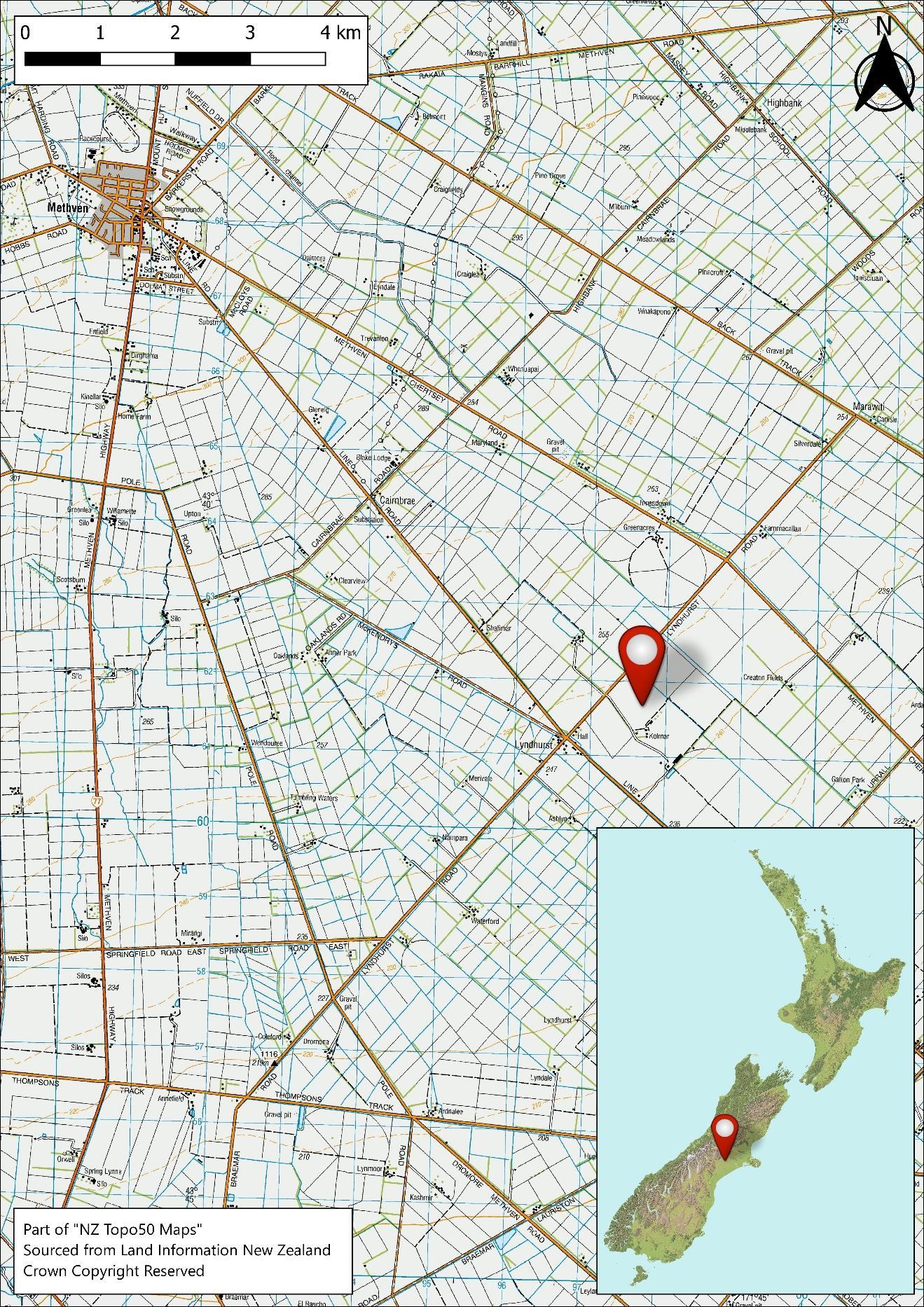
What happened
- On 1 January 2022, an Ultramagic Balloons, N-250 hot air balloon, registered ZK-MET (the balloon), was undertaking a commercial scenic flight near Methven, Canterbury. On board were the pilot and seven passengers.
- The landing area was the second paddock in a series of paddocks immediately after crossing a road. The paddocks were wide, but short in the direction of travel. A power line ran along the side of the road, approximately perpendicular to the direction of travel.
- Approaching the landing point, the pilot activated the balloon’s fast deflation system by pulling down on a red-coloured rip line connected to a large vent at the top of the envelope (the part of the balloon that held the hot air and provided lift).
- The basket initially contacted the ground in a firm landing and then bounced, tipping over on its second contact with the ground and ejecting the pilot from the basket.
- The basket came to rest approximately 35 metres from the initial ground contact. All passengers remained in their braced landing positions until after the balloon had deflated.
- The pilot’s final position was behind the basket, with the rip line caught around their neck. This resulted in serious injury from the rope and the basket passing over the top of them. The passengers were not injured and the balloon was not damaged.
- The balloon was fitted with a pilot restraint harness, but the pilot did not wear it during the flight.
Why it happened
- Balloon landings are a safety-critical phase of flight and rely on the pilots’ ability to control the balloon.
- Balloon control relies in part on the weight of the basket’s contents remaining consistent. As such, the ejection of any contents, persons or otherwise during the landing phase affects the ability to control the balloon, and therefore affects the balloon’s landing. The loss of a pilot is the most critical scenario.
- Firm landings with associated tip-overs are not uncommon, and managed correctly they pose minimal risks. However, they can increase the risk of other adverse outcomes. The operator had identified the potential risk of a firm landing and tip-over and produced documentation in support of this. The pilot had also briefed the passengers before the flight, and again before landing.
- The Transport Accident Investigation Commission (Commission) found in this occurrence that the pilot’s briefings almost certainly helped to prevent injuries to the passengers.
- The risk of pilot ejection was not adequately understood. The Commission found that the pilot would almost certainly not have been ejected had they been wearing the pilot restraint harness that was fitted to the basket. The operator’s procedures required the pilot to wear a pilot restraint harness; however, the Civil Aviation Rules specifically exempted balloon pilots from using pilot restraint harnesses during landing.
- On 22 February 2022 the Commission issued an urgent recommendation that the Director of Civil Aviation take prompt steps to mandate the wearing of pilot restraint harnesses during critical phases of balloon flight
What we can learn
- Balloon pilots should wear pilot restraint harnesses for critical phases of flight.
- Balloon owners and operators should install pilot restraint harnesses if they are not already fitted into the balloon basket.
- Passenger safety briefings are essential to passenger safety. It is essential that briefings are clear and concise and that passengers listen to and understand them. There is an added benefit in practising brace positions prior to flight.
Who may benefit
- Balloon operators, pilots and passengers may all benefit from the findings and recommendations in this report.
Factual information Pārongo pono
Narrative
- On Saturday 1 January 2022, ZK-MET, an Ultramagic Balloons, N-250 hot air balloon (the balloon), was on a commercial scenic flight near Methven. On board were the pilot and seven passengers.
- On the previous evening there had been a forecast of early morning cloud, so the pilot had delayed the original meeting time of 0600 (Times in this report are in New Zealand Daylight Time (Universal Co-ordinated time +13 hours) expressed in the 24-hour format) by one hour, to 0700. At 0610 the pilot obtained a MetFlight weather briefing. After reviewing the weather information, the pilot made the decision to continue with the flight. At 0700 the passengers met the crew at a prearranged location in Methven and were taken by bus, with the balloon towed behind on a trailer, to the launch location (the operator had several launch locations in the local area. The decision to use a particular location was made on the day, dependent on local conditions).
- While on the bus, the passengers were given briefing cards that detailed the normal and abnormal procedures for passengers in the balloon (see Appendix 1).
- At about 0730 the bus arrived at the launch site, and the balloon pilot gave a verbal briefing to the passengers prior to inflating the balloon.
- The passengers were invited to assist with the setting up and inflation of the balloon. This is a normal part of balloon operations due to the collective effort required to unpack and inflate a hot air balloon.
- After boarding the balloon, the passengers were asked to practise their landing positions prior to take-off.
- The flight departed at about 0814 from the Pudding Hill Road launch site, climbing to a maximum altitude of about 7400 feet (2255 metres) above mean sea level. The balloon tracked initially to the north-east, then turned to the south-east and passed to the east of Methven. The flight itself, while most likely novel for the passengers, was operationally unremarkable prior to the landing.
- The ground crew followed the balloon in the bus and communicated regularly with the pilot during the flight.
- By 0900 the pilot had descended and was starting to look for potential landing sites. At about 0905, with the anticipated landing area in sight, the pilot began preparations for the approach and landing, including briefing the passengers to expect a “bumpy” landing.
- The landing area was the second paddock in a series of paddocks immediately after crossing a road. The paddocks were wide, but short in the direction of travel. A power line ran along the side of the road, approximately perpendicular to the direction of travel. The passengers were all in their landing positions with their backs to the direction of travel prior to crossing the power line and road. The balloon’s approach path was over the power lines then a relatively steep descent to the second paddock.
- Approaching the landing spot, the pilot activated the balloon’s fast deflation system (FDS) (the balloon flight manual states that the FDS “has the advantage that if the rope is released, the opening remains as it was left”) by pulling down on the rip line connected to a vent at the top of the envelope. The basket landed upright initially, then “bounced”, tipping over on the second contact with the ground. The balloon landed at about 0907.
- The pilot was ejected from the basket after it bounced. The basket passed over the pilot. Witness marks on the ground indicated the pilot was then dragged along the ground.
- The basket and deflating envelope came to rest about 35 metres from the initial touchdown point, with all passengers remaining in their braced landing positions. Witnesses recalled that one passenger reminded the others to remain in the basket until after the envelope had deflated, in accordance with the earlier passenger briefing.
- The pilot’s final position was behind the basket with the rip line caught around their neck, resulting in serious injury. The passengers were not injured, and the envelope and basket were not damaged.
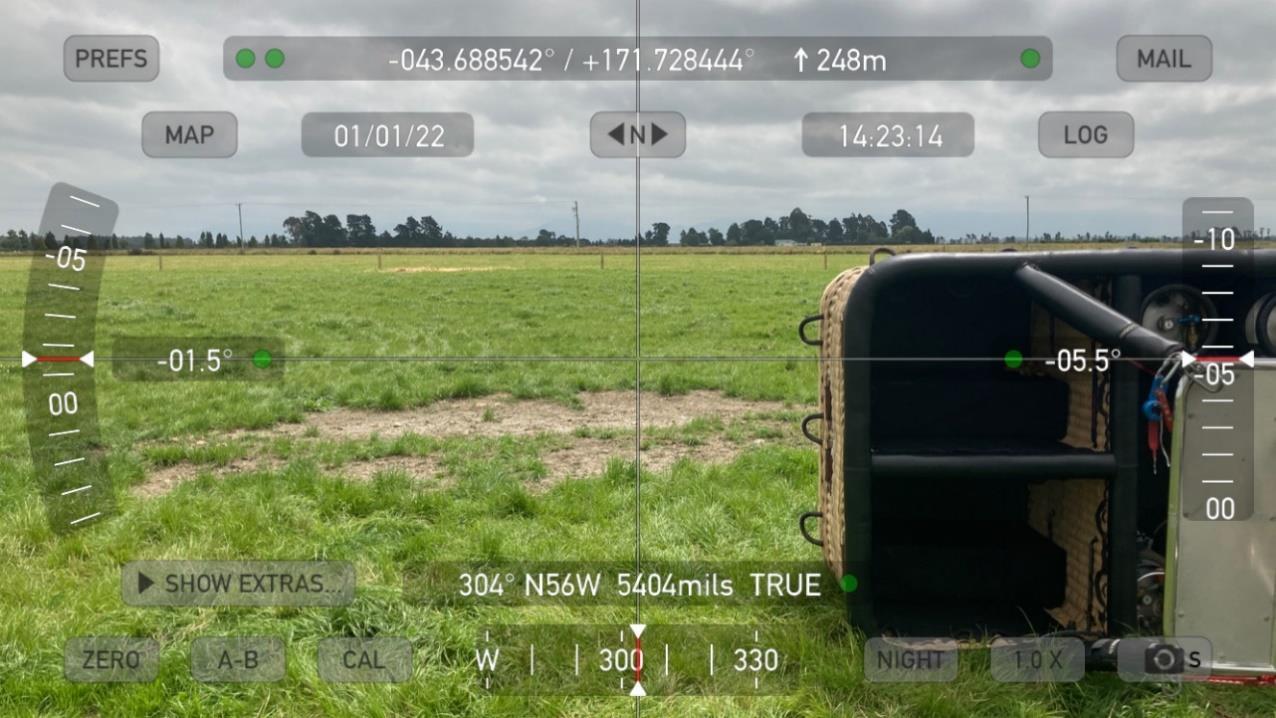
(Image taken by Transport Accident Investigation Commission investigators on the day of the occurrence)
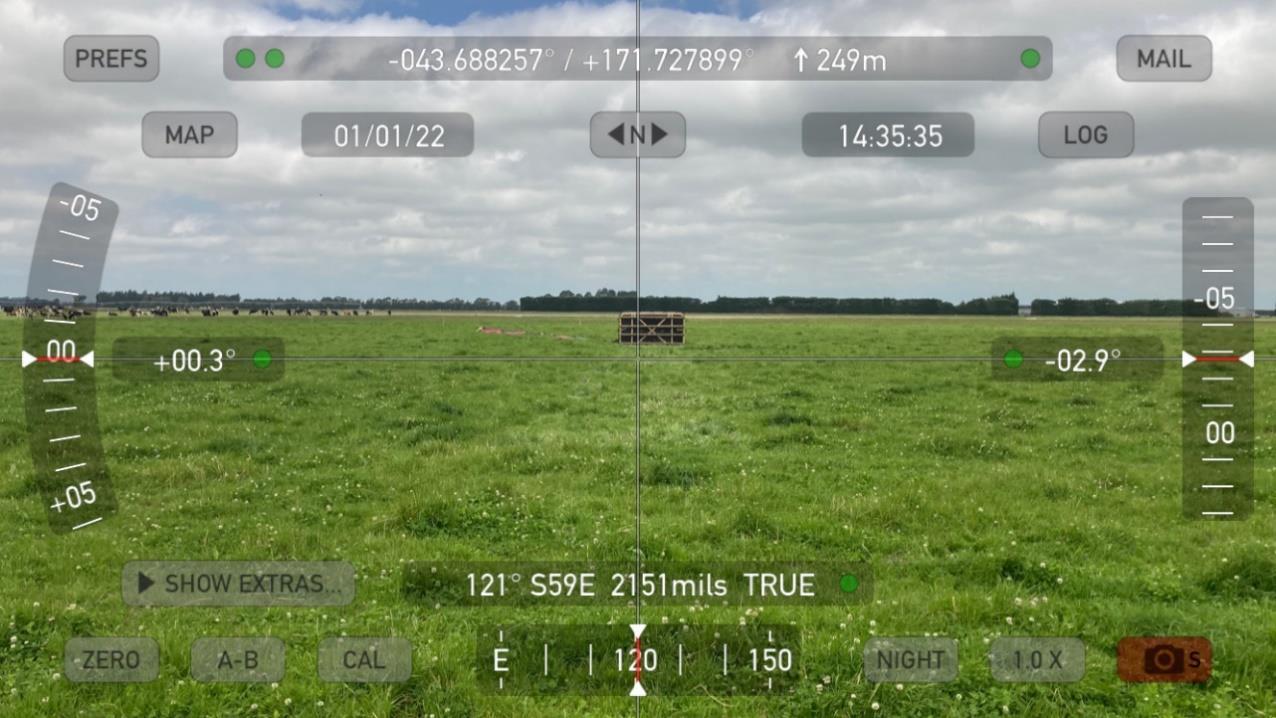
(Image taken by Transport Accident Investigation Commission investigators on the day of the occurrence)
- Passengers rendered first aid, including removing the rope from around the pilot’s neck.

(Image taken by Transport Accident Investigation Commission investigators on the day of the occurrence)
- At about 0940 emergency services arrived at the site, having been called by one of the passengers. The pilot was transported to hospital with serious injuries. They have since made a full recovery.
- The balloon was fitted with a pilot restraint harness. The pilot and witnesses recalled that the pilot was not wearing the pilot restraint harness during the flight. See Figure 5.
Personnel information
- The pilot, aged 67, held a Commercial Balloon Pilot Licence initially issued in October 2009. The New Zealand licence had been issued based on a United Kingdom (UK) Civil Aviation Authority licence held.
- The pilot had about 2670 hours’ total flying time, of which about 2300 had been in balloons.
- The pilot had conducted three flights totalling 3.35 hours in the previous seven days.
- The pilot held a current Class 1 medical certificate, valid until 27 January 2022. The certificate required the pilot to wear trifocal spectacles and to have a spare set of spectacles readily available. The pilot was wearing spectacles in photos taken during the flight.
- The pilot reported going out early the night before but stated that they had gone home at about 1830. Medical records showed no trace of drugs or alcohol in the pilot’s system on their admission to hospital.
- The pilot stated that they had slept well prior to the incident and that they were not fatigued at the time of the occurrence. The ground crew person, and some passengers who knew the pilot, commented that they had had no concerns about the pilot’s health prior to the occurrence.
Aircraft information
ZK-MET was an Ultramagic Balloons, N-250 hot air balloon, manufactured in Spain in 2020 and imported new to New Zealand the same year.
The basket was a double T partitioned basket with four passenger compartments, capable of taking up to 12 passengers. The pilot stood in the centre partition with the gas bottles and control lines (in the context of a balloon, a rope of a specific colour, depending on its purpose). See Figure 6.
The engine consisted of three combination blast/whisper burners with four liquified-petroleum-gas fuel tanks giving a nominal endurance of greater than three hours.
The basket was fitted with a dedicated pilot restraint harness, installed at manufacture. The pilot restraint harness consisted of a waist belt with a quick-release mechanism, which was attached via an adjustable strop to a dedicated hard point on the floor of the basket. See Figure 7.
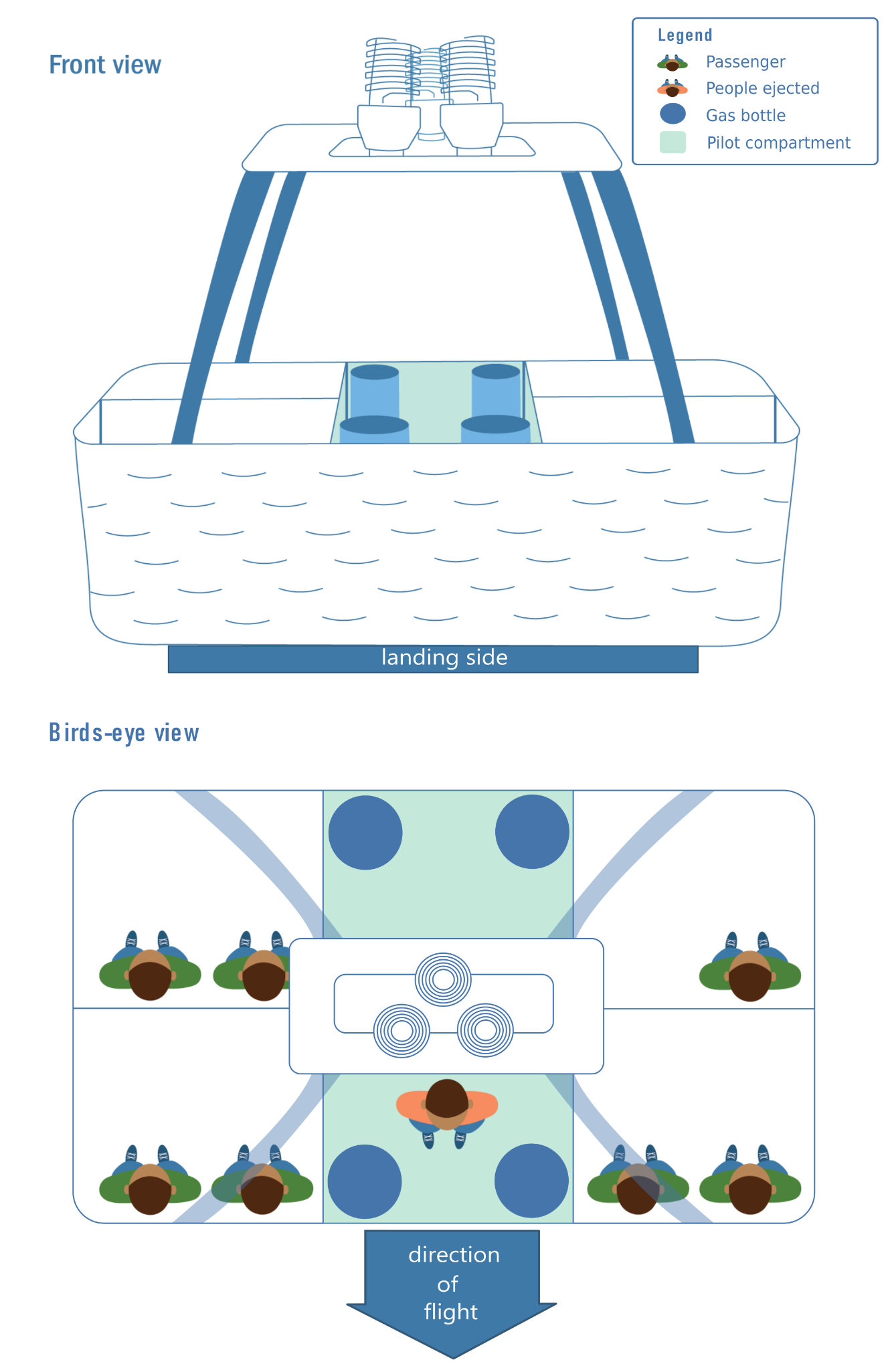

Meteorological information
- MetFlight data, as recorded on the flight load sheet by the pilot prior to the flight, was:
- 2000-foot (2000 feet (609 metres) above ground level) wind: 250 degrees at 20 knots (one knot equals one nautical mile (1.852 kilometres) per hour)
- visibility was 30 kilometres
- nil significant weather
- nil significant cloud
- temperature: 12 degrees Celsius
- QNH (mean sea level pressure) 1012 hectopascals.
Site and wreckage information
- The landing area was in a flat dairy paddock, on a farm located 1 kilometre north-east of Lyndhurst and 9 kilometres south-east of Methven. The farm was located to the east of Lyndhurst Road, which the balloon crossed on the final approach. See Figure 8.
- The paddock was the second in a series of paddocks that were rectangular in shape, with the long edge parallel to the road and perpendicular to the direction of travel of the balloon. The ground was grassed but hard.
- There was a low-voltage distribution power line running parallel to the road, on the western side. The power lines ran about 6 metres above the ground.
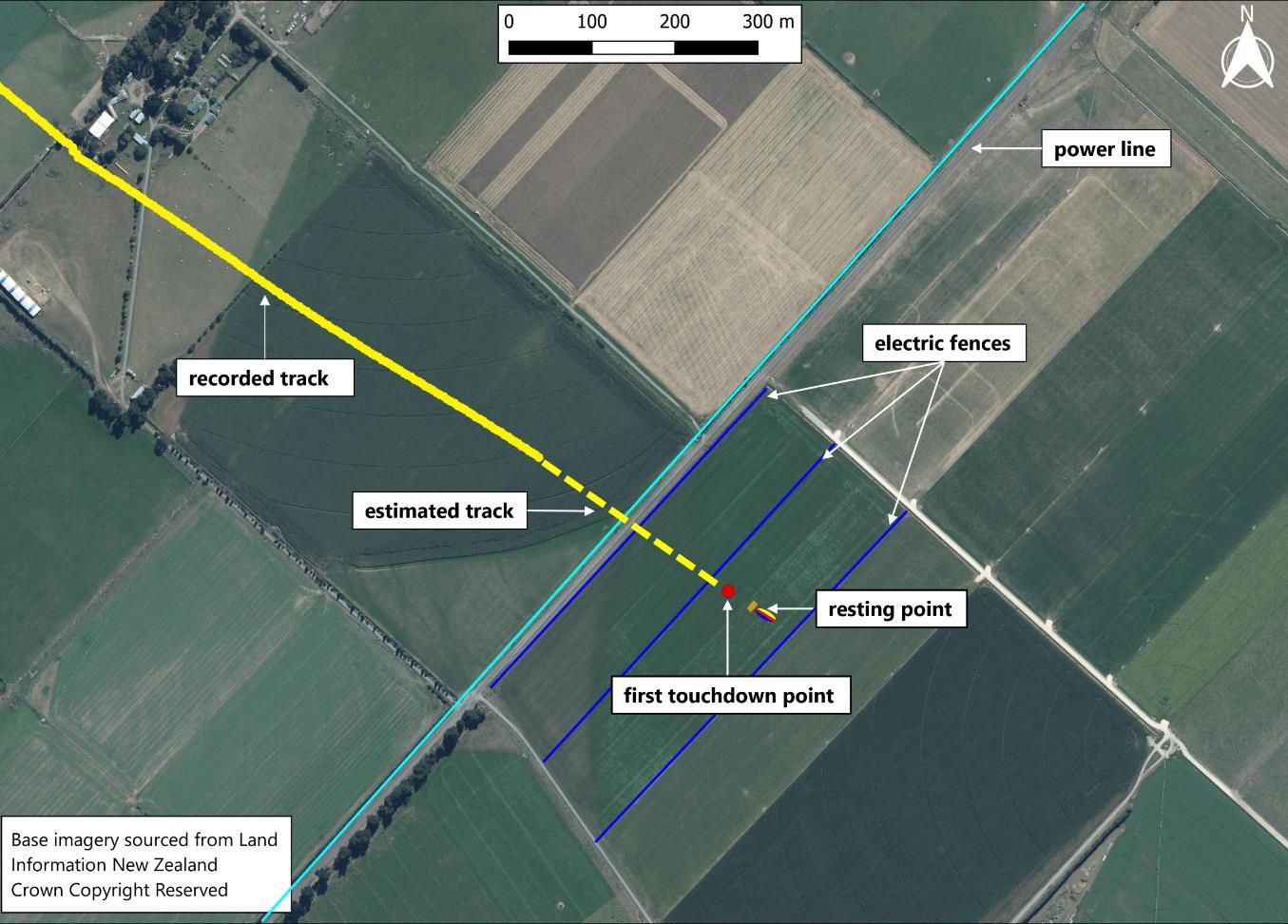
Medical and pathological information
- The pilot received serious injuries during the accident sequence, including fractures in the neck and temporary asphyxiation11 due to the control rope being caught around their neck.
- Through the quick intervention and application of first aid by the passengers, the pilot was stabilised until the arrival of paramedics. The pilot spent two weeks in hospital before making a full recovery.
Previous occurrences
- On 9 July 2021, ZK-FBK, a Kavanagh Balloons E-260 hot air balloon, was on a commercial scenic flight in the Wakatipu Basin near Queenstown. On board were the pilot and 10 passengers. As the balloon descended in a wind of about 16 knots (30 kilometres per hour), the basket struck the sloping ground leading up to a paddock from an adjacent gully. The pilot, who was not wearing a pilot restraint harness, was ejected from the basket as a result. The deflating envelope and basket came to rest after approximately 150 metres. The pilot sustained serious injuries. This occurrence was investigated by the Transport Accident Investigation Commission (Commission), investigation number AO-2021-001.
-
On 16 July 2016, near York, Western Australia, VH-LPG, a Kavanagh Balloons E-300 hot air balloon, had a hard landing12 that resulted in the pilot being ejected from the basket. Investigation AO-2016-080 by the Australian Transport Safety Bureau found that no pilot restraint harness had been fitted to the balloon.
The final report had the following safety message:
Installation and use of a pilot restraint harness, in accordance with the balloon and harness manufacturers’ [sic] recommendations, will reduce the risk of a pilot being thrown out of the balloon basket during landing. (Australian Transport Safety Bureau, 2016)
Organisational information
- The operator was certificated as an adventure aviation operation by the Civil Aviation Authority of New Zealand (CAA), under Civil Aviation Rules (CARs) Part 115: Adventure Aviation Certification and Operations. The operating certificate permitted the operator to conduct commercial adventure aviation flights in a hot air balloon in accordance with its exposition.
Analysis Tātaritanga
Introduction
- The flight was a typical balloon scenic flight until the landing sequence. Of note early on were the thorough passenger briefings, which almost certainly contributed to the positive outcome for the passengers, of whom some commented that they would happily fly with the pilot again.
- The only departure from a routine flight was the pilot being ejected from the basket during the landing sequence, almost certainly because of a combination of a firm landing and the pilot not wearing a pilot restraint harness.
- The following section analyses the circumstances surrounding the event to identify those factors that increased the likelihood of the event occurring or increased the severity of its outcome. It also examines one safety issue that has the potential to adversely affect future operations.
Use of a pilot restraint harness during the landing phase of balloon operations
Safety issue: Balloon pilots were exempt from the requirement to wear a pilot restraint harness when operating a balloon.
- The landing was firm enough to tip the basket over. However, this was not unusual (the pilot estimated that about 25 per cent of their landings were tip-over landings), and its eventuality was included in the passenger briefings. Had the pilot been wearing a pilot restraint harness on landing, it is virtually certain that it would have been a routine landing with no adverse outcome.
- With the ejection of the pilot there was no one able to control the balloon. In some circumstances the reduction in weight caused by a pilot and/or a passenger falling overboard can result in the balloon taking longer to come to a halt, or even the balloon becoming airborne again.
- The pilot stated that they had worn their pilot restraint harness in the UK, where it was compulsory, putting it on prior to take-off. They stated that they had not worn their pilot restraint harness on every occasion when flying in New Zealand, as it was not compulsory under the CARs.
- Furthermore, the pilot commented that because of the increasing wind strength encountered as the balloon descended, and their focus on the need to land in a narrow paddock, they had forgotten to put on the harness.
-
Under the CARs, balloon pilots in New Zealand are exempt from wearing pilot restraint harnesses during landing.
Civil Aviation Rule 91.205: Crew members at stations:
(a) Each crew member on duty during take-off and landing in an aircraft, other than in a balloon, shall—
(1) be at their crew member station unless their absence is necessary to perform duties in connection with the operation of the aircraft; and
(2) have their safety belt fastened while at the crew member station. -
However, despite CAR 91.205, the operator’s exposition stated that:
All PIC on approach to landing and always when below 500 ft agl16 shall wear a properly connected and adjusted pilot restraint harness.
-
In New Zealand, the CARs are the minimum standards for safe operations. Operators can choose to set higher standards of safety in their exposition, which is approved by the regulator. The standards set in the exposition then become the minimum standards for those operators, regardless of whether other CARs have exemptions. For CARs Part 115 operators, they are set out in CARs Part 115, 101(b)(2):
(b) A holder of an adventure aviation operator certificate must—
(2) comply with every procedure and programme detailed in the certificate holder’s exposition - The operator’s exposition required pilots to wear a restraint harness during landing, in effect making that the rule for all pilots operating under that exposition.
- The reason the exposition went further was not determined, especially as the operator’s Safety Management System, certified by the CAA on 15 December 2020, did not identify the risk of pilot ejection on landing. Nevertheless, the Commission encourages the use of expositions for increasing transport safety.
- 3.13. This occurrence and another recent occurrence in New Zealand (inquiry number AO-2021-001), also involving a pilot being ejected from their basket during a landing sequence, resulted in pilot injury and a loss of balloon control.
- The baskets of commercial balloons typically have multiple compartments, with the pilots occupying compartments separately from the passengers. The baskets of the balloons involved in the two occurrences were of a double T design, with separate pilot compartments in the centre of the baskets. The design enabled the pilots to move freely about their compartments and not tangle with passengers or allow passengers to tangle with the various control lines. Private balloons are typically smaller than commercial balloons, with no internal partitions and fewer control lines.
- As was the case for other major balloon manufacturers complying with the European Union Aviation Safety Agency standards, pilot restraint harnesses had been installed in the balloons during their manufacture. The use of the pilot restraint harnesses was not mandated in the flight manuals, but the use of any occupant restraints was subject to local regulations (Ultramagic Balloons Flight Manual for Ultramagic Balloons Hot Air Balloons).
- These two occurrences together highlight the need to address this safety issue urgently. The Commission has focused on commercial balloon operations for the above reasons; however, it should be highlighted that private balloon operators may also benefit from the fitting of pilot restraint harnesses should it be deemed appropriate.
Control line management
- The primary method of control in a hot air balloon is the opening and closing of vents to alter the amount and temperature of the air within the envelope. This is achieved using control lines that run from the vents to the pilot position in the basket.
- When the FDS line is pulled on landing, it is done by hand, with the excess line collecting on the floor of the pilot’s compartment. There may be several metres of rope pulled in, which can create a hazard to a pilot during landing.
- However, during the activation of the FDS line there is unlikely to be sufficient time to stow the loose line neatly.
- As it is for all hazards, an operator needs to take care to manage the risks associated with the excess line spooling around a pilot’s legs.
Passenger briefing
- The pilot conducted a series of passenger briefings before the flight, beginning with the issue of the passenger briefing cards while travelling on the bus to the launch location. This was complemented by a general discussion on the intended conduct of the flight, and the opportunity for passengers to ask questions.
- Once on site, a further briefing was conducted prior to the inflation of the balloon, and again once the balloon was inflated and the passengers had boarded.
- The last briefing included a practice of the landing and brace positions.
- The landing was firm, like the landing sequence shown on the briefing cards given to the passengers prior to the flight.
- It is virtually certain that the thorough safety briefings, including the brace position practice, and the easy-to-understand graphical nature of the briefing card assisted in preventing injuries to the passengers in this occurrence.
Findings Ngā kitenga
- The weather and forecast were suitable for the balloon flight.
- The balloon was in good condition during the flight.
- The passengers sustained no injuries.
- The pilot briefings almost certainly helped prevent injuries to the passengers.
- Civil Aviation Rule 91.205 exempts balloon pilots from a requirement to wear pilot restraint harnesses during landing.
- The pilot was not wearing the pilot restraint harness that was fitted to the basket, despite the requirement in the operator’s exposition that they wear the pilot restraint harness.
- The pilot sustained serious injuries as a result of their being ejected from the basket during the landing sequence.
- Had the pilot been wearing a pilot restraint harness they would almost certainly not have been ejected.
Safety issue and remedial action Ngā take haumanu me ngā mahi whakatika
General
- Safety issues are an output from the Commission’s analysis. They may not always relate to factors directly contributing to the accident or incident. They typically describe a system problem that has the potential to adversely affect future transport safety.
- Safety issues may be addressed by safety actions taken by a participant, otherwise the Commission may issue a recommendation to address the issue.
Use of a pilot restraint harness during the landing phase of balloon operations
- Under the CARs, balloon pilots in New Zealand are exempt from wearing pilot restraint harnesses during landing.19 However, the operator had included in its exposition a requirement for the pilot to wear a restraint harness.
- Where an operator’s exposition enhances a rule by providing a higher safety standard, a pilot must adhere to the higher standard provided in the exposition and cannot choose to follow the lower standard provided by the rule. Despite this, the pilot still elected not to wear a harness for this flight.
- This and another recent occurrence20 of a pilot being ejected from their basket during a landing sequence resulted in pilot injury and a loss of control of the balloons. These occurrences together highlighted the need to address this safety issue.
- The baskets of commercial balloons typically have multiple compartments, with the pilots occupying compartments separately from the passengers. The baskets of the balloons involved in the two occurrences were of a double T design, with separate pilot compartments across the centre of the baskets. The design enabled a pilot to move freely about their compartment and not tangle with a passenger or allow a passenger to tangle with the various control lines. Private balloons are typically smaller than commercial balloons, with no internal partitions and fewer control lines. The risk of entanglement in private balloons is therefore less than it is for commercial balloons.
-
On 22 February 2022 the Commission made a recommendation to the Director of Civil Aviation (the Director) to address this issue.
that the Director of Civil Aviation take prompt steps to mandate the wearing of pilot restraint harnesses during critical phases of commercial balloon flights. (001/22)
- In response, on 30 March 2022 the Director advised the Commission that, while supportive of the recommendation, the Director could not change CARs, as amending them was the sole responsibility of the Minister of Transport. The Director advised that they would, however, recommend to the Ministry of Transport that the rule be amended, acknowledging that this would take time.
- The Director advised that, subsequent to the accident, the CAA had contacted the four commercial balloon operators currently operating in New Zealand to make them aware of the safety risk of commercial balloon pilots not wearing pilot restraint harnesses. The Director advised that the four commercial balloon operators had subsequently incorporated in their Safety Management Systems a requirement for pilots to wear pilot restraint harnesses during critical phases of flight.
- In responding to the Commission, the Director advised that other regulatory tools available to the Director to take urgent action were not appropriate and likely difficult to justify in this instance. This was because any immediate safety risks had been addressed by the industry’s voluntary action, noting this would be as effective as, if not more effective than, formal mandates.
-
On 16 November 2022 the Commission redirected a draft safety recommendation to the Secretary of Transport. On 7 December 2022 the Acting Secretary of Transport responded:
As all the four operators involved in this activity are already implementing the recommendations put forward by the Commission, and that the operators’ safety management systems requires the wearing of pilot restraints, the Ministry believes that adequate steps are already in place to address the Commission’s recommendations. Furthermore, the CAA has agreed to monitor voluntary compliance for a period of time and use that information to form an evidenced view on whether the residual risk alluded to in paragraph 5.11 of the Commission’s draft report continues to exist. If it does, then an amendment to Civil Aviation Rules might be justified.
- Notwithstanding the Director’s and the Secretary of Transport’s positions, the Commission noted that the operator involved in the accident had already been required to wear a safety harness under their exposition, and therefore voluntary changes by operators might not resolve the safety issue identified. This would especially be so when non-compliance went undetected. Consequently, and while continuing to believe there remains a residual safety risk in the system, the Commission considers that there is merit in amending the appropriate CARs to mandate the wearing of pilot restraint harnesses during critical phases of flight for commercial balloon pilots.
- This approach is consistent with the Commission’s future transport safety focus and seeks to ensure persons and operators entering the industry in the future benefit from the learnings of this report.
- The Commission welcomes the safety actions to date. However, it believes more action needs to be taken to ensure the safety of future operations. Therefore, the Commission has made a recommendation in section 6 to address the outstanding residual safety risk in the system.
Recommendation Ngā tūtohutanga
General
- The Commission issues recommendations to address safety issues found in its investigations. Recommendations may be addressed to organisations or people, and can relate to safety issues found within an organisation or within the wider transport system that have the potential to contribute to future transport accidents and incidents.
- In the interests of transport safety, it is important that recommendations are implemented without delay to help prevent similar accidents or incidents occurring in the future.
New recommendation
- On 30 March 2023, the Commission recommended that the Secretary of Transport review and revise Civil Aviation Rules Part 91 to mandate the wearing of pilot restraint harnesses during critical phases of commercial balloon flights. (001/23)
-
On 13 April 2023, the Secretary of Transport replied in part:
You have asked how I intend to respond to this recommendation. In accordance with the terminology used by the Commission, I advise that the recommendation is “Under consideration”. This is because as noted in the Ministry’s response of 7 December 2022 to the Commission’s draft recommendation, all the four operators involved in this activity are already implementing the recommendations put forward by the Commission, and that the operators’ safety management systems requires the wearing of pilot restraints. The Ministry believes that adequate steps are already in place to address the Commission’s recommendations. Furthermore, the Civil Aviation Authority (CAA) has agreed to monitor voluntary compliance for a period of time and use that information to form an evidenced view on whether the residual risk alluded to in paragraph 5.11 of the Commission’s draft report continues to exist. If it does, then an amendment to Civil Aviation Rules might be justified.
As you will appreciate, the development of Civil Aviation Rules is undertaken together with the CAA. Given the small size of the commercial balloon operation sector in New Zealand (four operators), the mitigations already in place, and competing priorities, the recommended revision is unlikely to be prioritised in the near-medium term, unless the risk outlook for the commercial balloon operation sector changes significantly to the detriment of safety.
Key lessons Ngā akoranga matua
- When pilot restraint harnesses are fitted, balloon pilots should wear them for critical phases of flight.
- Balloon owners and operators should consider installing pilot restraint harnesses (in accordance with Civil Aviation Rules for modifying aircraft) if they are not already fitted to their baskets.
- Thorough safety briefings, including landing-position practices, are critical for passenger safety during aircraft operations, as demonstrated by this occurrence.
- Balloon operators should ensure that adequate steps are taken to manage the risks associated with control lines in pilot compartments during operations.
Data summary Whakarāpopoto raraunga
Details
latitude: 43° 41.348´
longitude: 171° 43.613´
Conduct of the inquiry He tikanga rapunga
- On 1 January 2022, the CAA notified the Commission of the occurrence. The Commission subsequently opened an inquiry under section 13(1) of the Transport Accident Investigation Commission Act 1990 and appointed an investigator in charge.
- Commission investigators travelled to the accident site on 1 January 2022 to conduct a site inspection. They inspected and secured the balloon and basket. Five of the seven passengers and the ground support person were interviewed on 1-2 January 2022.
- Investigators interviewed the balloon pilot on 11 January 2022. The remaining two passengers were interviewed on 13 January 2022.
- On 22 February 2022 the Commission approved the publication of a preliminary factual report for the purpose of issuing an urgent safety recommendation.
- On 26 October 2022 the Commission approved a draft report for circulation to five interested persons for their comments.
- The Commission received four responses, one of which was a submission. Changes as a result of the submission have been included in the final report.
- On 30 March 2023 the Commission approved the final report for publication.
Glossary Kuputaka
- Control line
- In the context of a balloon, a rope of a specific colour, depending on its purpose
- Envelope
- The part of the balloon that holds the hot air and provides lift.
- Knot
- A measurement of speed in nautical miles per hour, equivalent to 1.85 km/h.
Citations Ngā tohutoru
Australian Transport Safety Bureau. (2016). Hard landing involving Kavanagh Balloons E-300 VH- LPG. Canberra: Australian Transport Safety Bureau.
SKYbrary. (2022). Hard Landing. Retrieved from SKYbrary
Appendix 1. Passenger briefing card
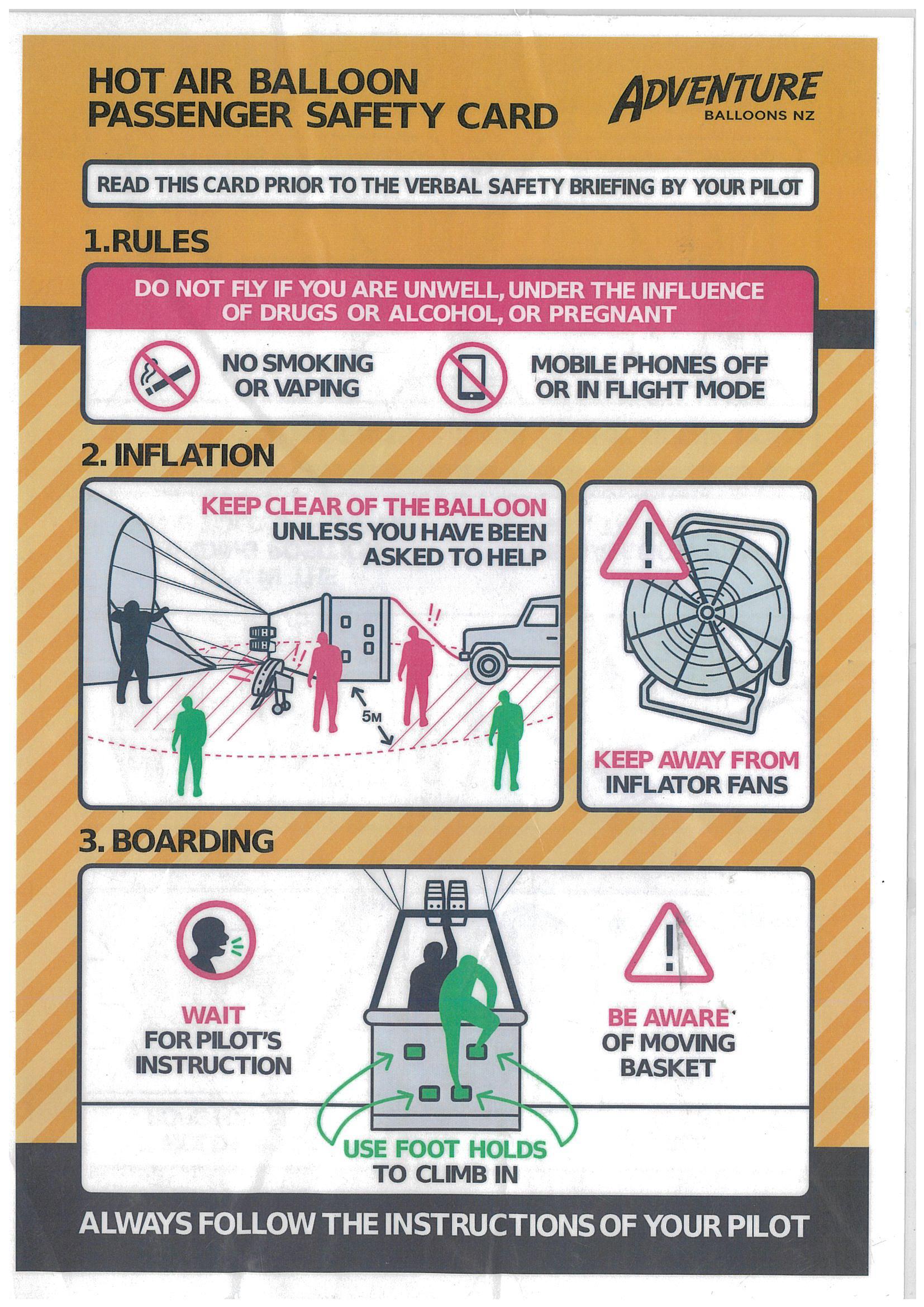
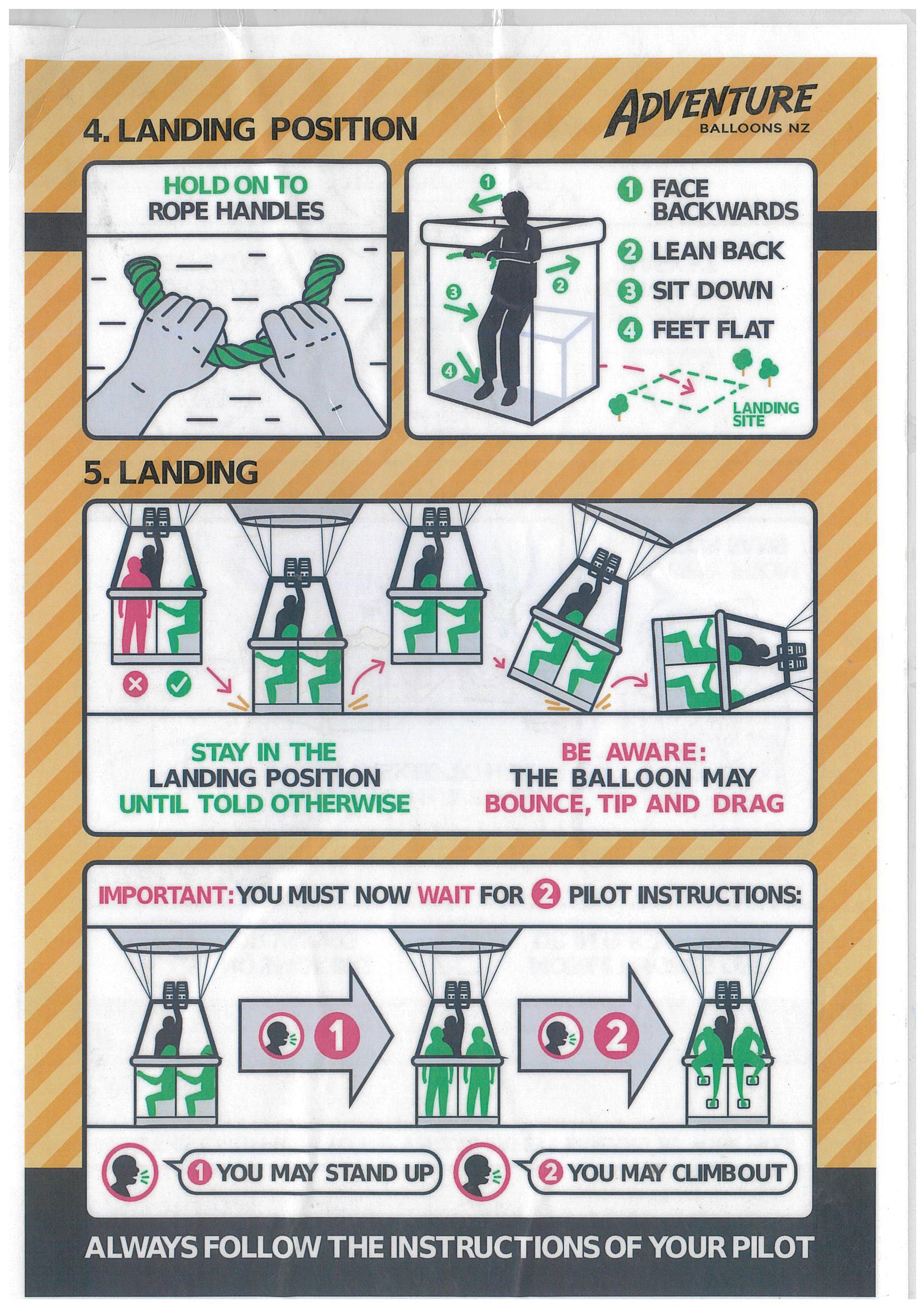
Document downloads
Related Recommendations
The Commission recommended that the Secretary of Transport review and revise Civil Aviation Rule Part 91 to mandate the wearing of pilot restraint harnesses during critical phases of commercial balloon flights. (001/23)
On 22 February 2022, the Commission recommends that the Director of Civil Aviation undertake prompt steps to mandate the wearing of pilot restraint harnesses during critical phases of balloon flight.
